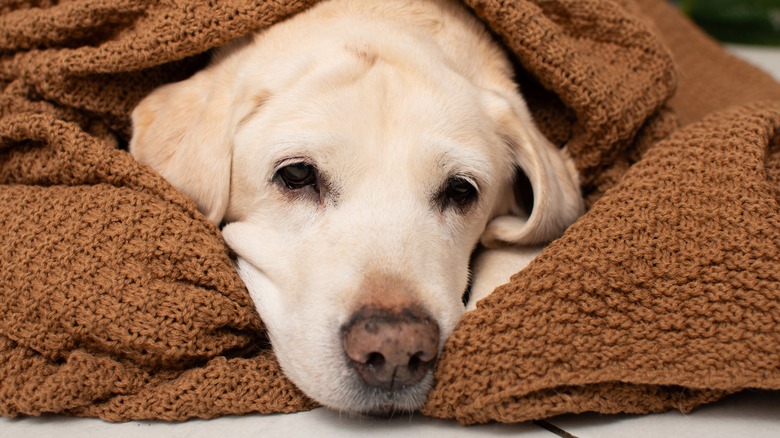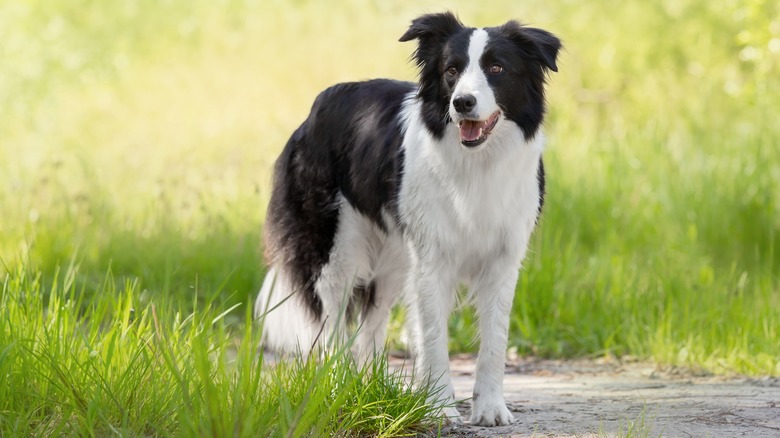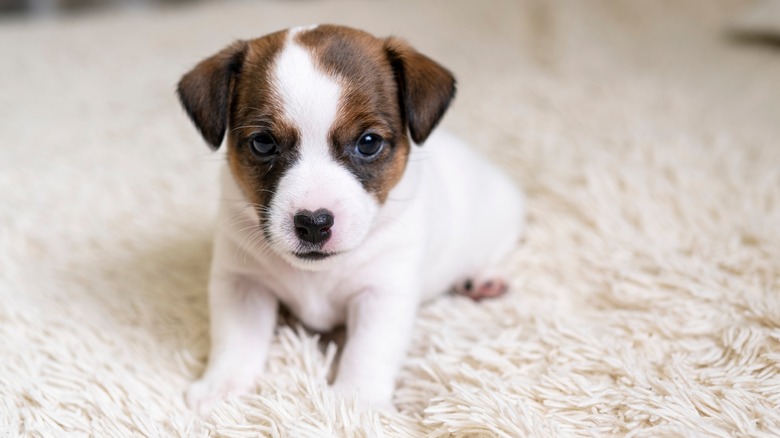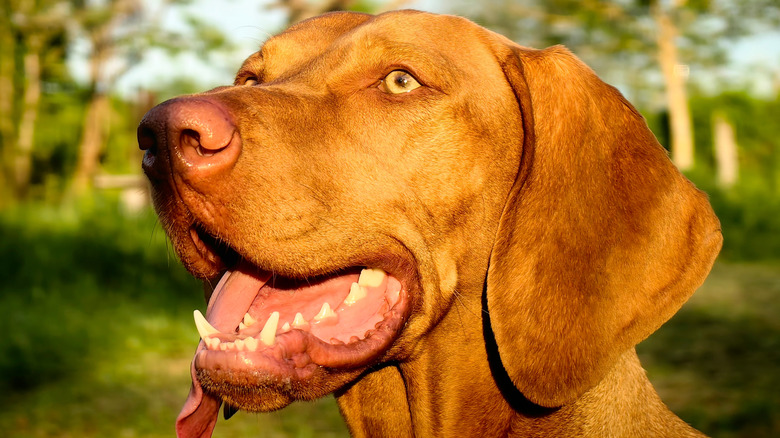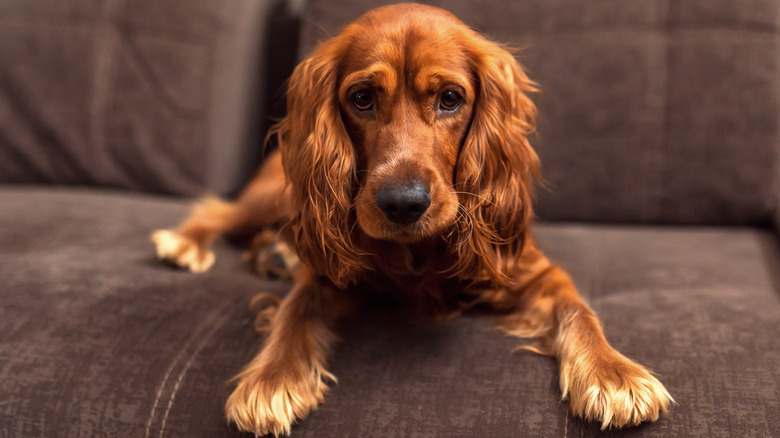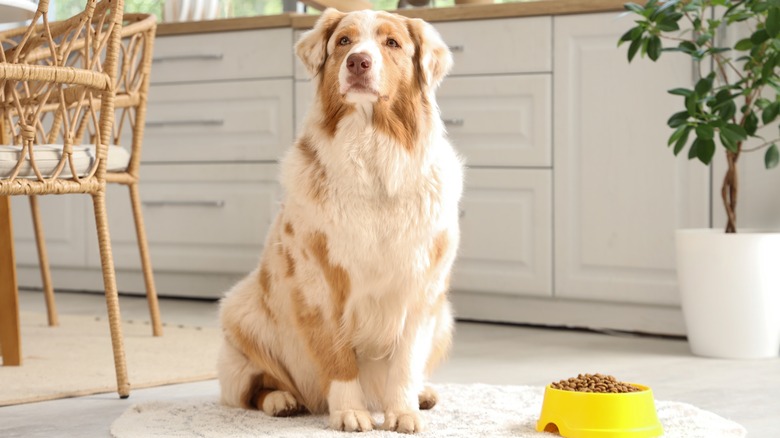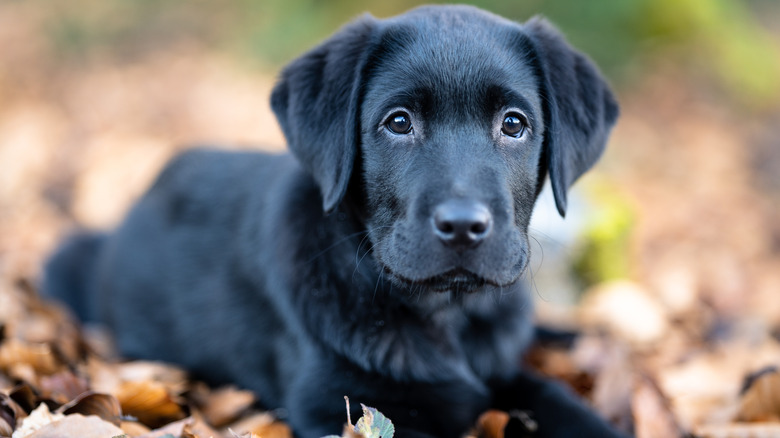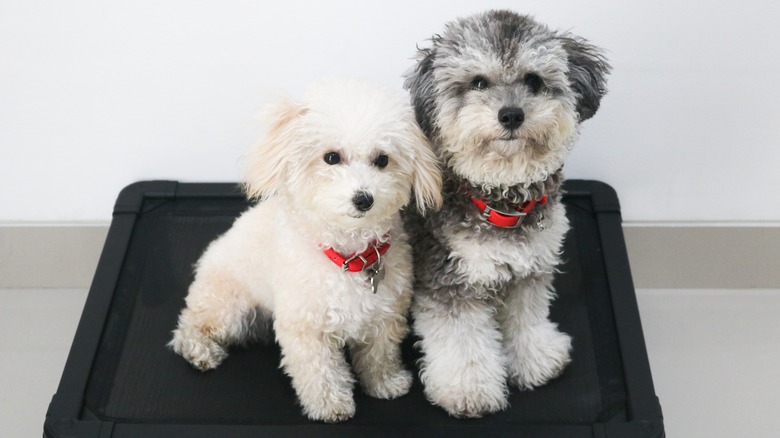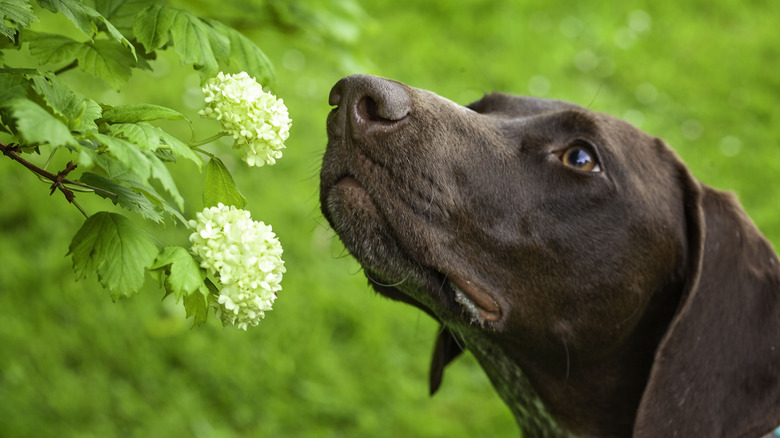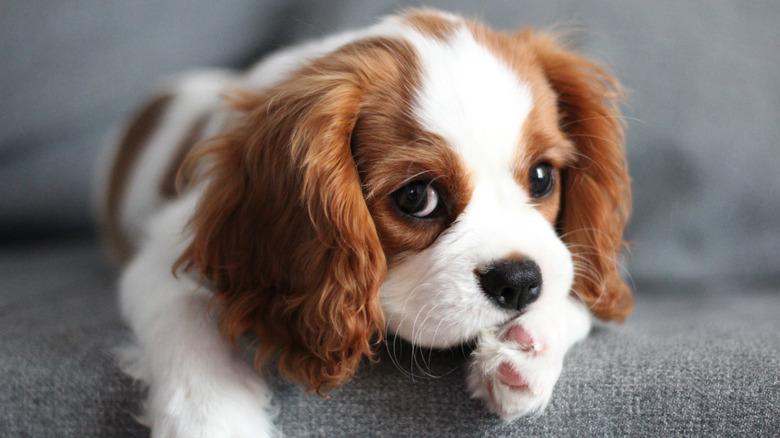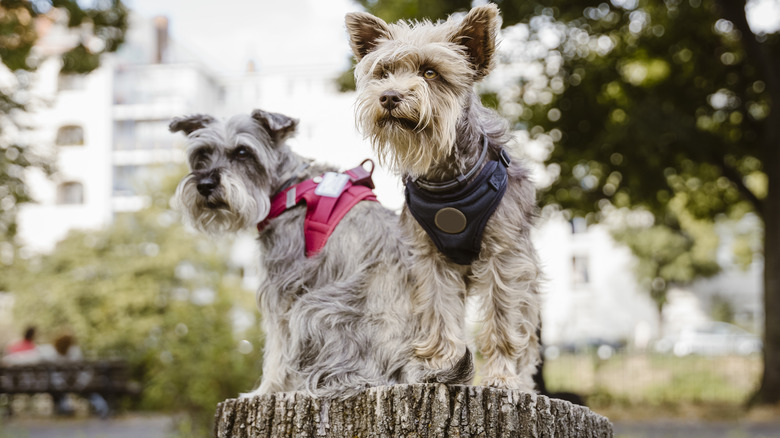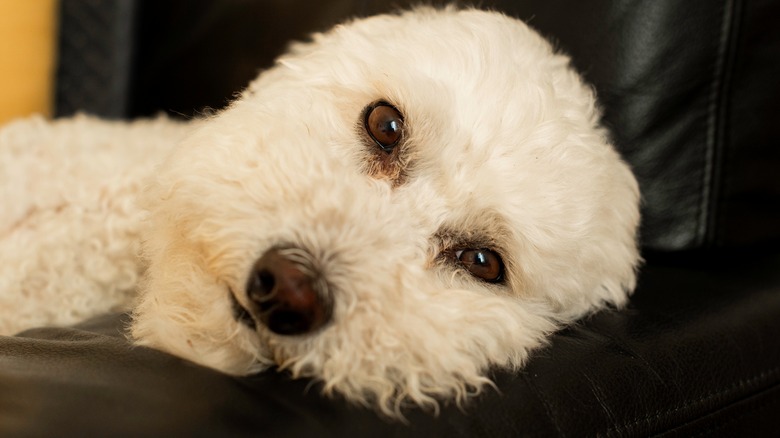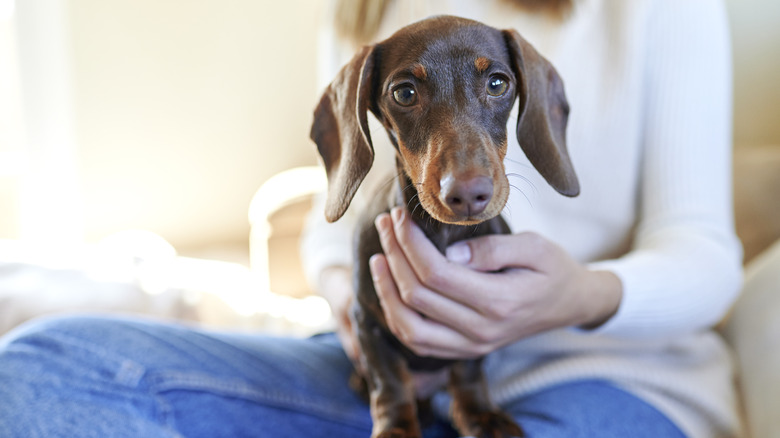14 Dog Breeds With The Highest Likelihood Of Having Anxiety Issues
Dogs are furry, lovable goofballs, so when anxiety starts making your pup behave erratically, it can be incredibly stressful. Unfortunately, 2020 research published in Scientific Reports shows that more dogs than you might think engage in anxiety-induced behavior, with 32% of the 13,700 dogs studied becoming anxious from noise alone. The source of your dog's anxiety could be external, such as a loud, rattling noise that won't stop, or your four-legged best friend might have a genetic predisposition to be fearful. Furthermore, anxiety appears more often in some dog breeds than others. For example, affectionate lap dogs may adore their families so much that they often get separation anxiety.
Knowing which breeds are prone to anxiety becomes important when your pup has fearful tendencies or when you're thinking about adding a new dog to the family. Pet parents need to recognize the genetic component behind anxious behavior because it'll help them devise a treatment plan, and potential pet parents have hefty adoption decisions to make, as many families aren't equipped to care for an anxious dog. As such, here are 14 breeds that are likely to have anxiety problems so you can forge the best path forward for your dog.
1. Border collies don't typically like small spaces
Visit enough sheep farms, and you're bound to see a border collie racing through a field. These graceful, agile creatures were originally bred as herding dogs. Needless to say, these dogs enjoy life on the farm and use their intelligence to corral sheep and cattle. Border collies have excellent temperaments when they have a clear job to do, but when you take them away from fresh air and wide-open spaces, anxiety can creep in. Because of this, they aren't the best apartment dogs.
If you want to keep a border collie happy, give it plenty of exercise. You can go for long runs and hikes or let it play in a busy dog park. Moreover, training sessions can replace having a job. There's behavioral training if your pup is young or needs extra guidance, and there's also agility training, which is more like a sport for dogs. Consider your own activity level before adopting a border collie, too. They're the perfect companions for energetic pet owners with plenty of free time. Quieter households that spend little time outdoors may feel that this breed isn't a good fit for their home.
2. Jack Russell terriers can struggle with small dog syndrome
Jack Russell terriers are small hunting dogs with big personalities, and you might fall in love with their merry nature and high-energy play style. What's a bit harder to deal with is their tendency to grow anxious when under-stimulated. Clever Jack Russells crave mental and physical challenges, but you don't have to be an athlete to care for one. You can keep it occupied with rambunctious games of tug of war and fetch. Many Jack Russells also enjoy playing with puzzles that have hidden treats to discover.
In addition to boredom, pet parents have another Jack Russell anxiety issue to worry about: small dog syndrome. This describes how a small dog may overcompensate for its size by becoming aggressive. The aggression increases anxiety because the dog is always on edge, looking for the next threat. To prevent small dog syndrome, focus on consistent training and early socialization. It's important that your Jack Russell terrier learns how to be comfortable around other people and dogs early on.
3. Vizslas sometimes pace when they're anxious
Pretty, red-haired vizslas are among the most striking dogs you can have at your side. Their lithe grace and silken fur instantly attract the eye, and these dogs become even more charming when you get to know their gentle and sweet personalities. In fact, it's their sweetness that often leads to anxiety problems. There are different forms of canine anxiety, from fear of new situations to separation anxiety, and vizslas often have the latter, as they're so in tune with their families that they typically want to spend every moment together.
An anxious vizsla might pace continuously or sit with its ears back and eyes dilated. It might also act extra friendly and keep trying to lick you or jump on you. You may not mind the extra affection, but it's still problematic because it springs from fear rather than love. When they aren't snuggling with family, Vizslas love to romp and play. They're high-energy dogs that need daily exercise, so your home is a great match for a gorgeous vizsla if you have time to keep them stimulated and happy.
4. Chihuahuas' anxiety can come from boredom and small dog syndrome
Knowing how to identify a chihuahua isn't too hard — after all, it's smallest breed registered by the American Kennel Club (AKC). It's also the breed that the average person tends to associates with anxious behavior. Kyle Potts, former head of the Chihuahua Club of America, even told the AKC that some people believe that chihuahuas are "yappy" and "frail" despite this not being the case.
Anyone who spends time with this breed learns that chihuahuas are actually adventurous and loyal companions that can easily adapt to new situations. These attributes, combined with their small stature, make these dogs ideal apartment dwellers.Chihuahuas aren't "frail," but they're one of the breeds most affected by anxiety. They sometimes even shake in fear. Chihuahua anxiety can spring from a combination separation anxiety, small dog syndrome, and boredom.
You might be able to limit all three anxiety causes. Strict, routine training can treat separation anxiety, while pups with small dog syndrome can be treated with consistent training combined with socialization. Bored dogs simply crave games and exercise, so engaging with them can make all the difference in the world.
5. Cocker spaniels' anxiety can worsen because of some health conditions
If you want a dog that's going to shower you with love, you can't go wrong with a cocker spaniel. These adorable, long-eared pups are often adopted by families because they're friendly and gentle enough to be around kids. A less desirable trait is that cocker spaniels may have separation anxiety. One Reddit user shared that their cocker spaniel "swats" at them for attention. Another user described how their cocker spaniel "howls at the door" to hurry them inside whenever they arrive home. Whatever form it takes, seeing your dog fall prey to stress isn't easy.
Sadly, cocker spaniels are also vulnerable to ear and skin infections. The discomfort caused by these conditions can be an additional source of anxiety. Keeping your cocker spaniel safe means visiting the vet regularly and using training methods designed to ease separation anxiety. For example, one common strategy is to crate-train your puppy. If that doesn't work, you can give your dog a puzzle treat whenever you leave the house. That can help tame its anxiety response.
6. German shepherds need a lot of exercise to keep anxiety at bay
Known as one of the most loyal dog breeds, German shepherds were originally bred as hunting and herding dogs. However, the breed's obvious intelligence and clear strength meant they were quickly identified as superb police and military dogs, and they've since even become battlefield heroes.
Don't worry about these versatile working dogs not forming a bond with you, though. German shepherds are notably invested in their families and have a deep-rooted protective instinct. It's that instinct that can trigger anxiety. They may not be able to relax because they're always on the lookout for the next attack. Separation anxiety is also normal for German shepherds. They can get antsy when they can't be around their favorite people, and it may become so bad that your German shepherd gets stressed whenever you leave the room.
Many people who live with German shepherds say frequent exercise is the best cure for this anxiety. Some even suggest long daily walks plus plenty of games. The key is to tire the dog out so it's not stuck inside with pent-up energy.
7. Australian shepherds are watchdogs that may become anxious in small homes
Australian shepherds feel at home alongside ranchers and farmers. Mud, livestock, and the open air are part of their natural environment, so when you take this lean herding dog and put it indoors, it's not uncommon for anxiety issues to arise. Australian shepherds are extremely athletic, and their herding instincts are strong. If they can't herd large animals, they might switch to herding your family and additional pets. This can cause anxiety because you're constantly moving, and they can't herd you properly.
Even when the family is calm, an Australian shepherd might stay in watchdog mode. Continued stress might lead to the dog becoming fearful and reactive. Members of the Australian Shepherd Rescue of the Southeast Facebook group have reported that their dogs had severe anxiety that lasted longer than a year. However, be patient. They also said that once the anxiety was under control, their Australian shepherds became the most pleasant and affectionate friends imaginable. This breed will fit your lifestyle if you're active and willing to use training to curb herding instincts.
8. Labrador retrievers are people-pleasing dogs that can worry a lot
You might be surprised to see this entry on the list. Labrador retrievers are renowned for their gentle and friendly demeanor, even ranking among the most beloved dogs in the U.S. Yet, these sweet creatures are still susceptible to anxiety. Like many lovable companion dogs, Labrador retrievers have many advantages and disadvantages, including being more likely to experience separation anxiety. Labrador community groups focus on the breed's exemplary qualities, but there are plenty of stories about anxiety. Sometimes, the anxiety is so crippling that the dog's family can't leave the house without it destroying furniture and personal items.
Another potentially problematic quality is that labradors like to please the people around them. If you're stingy with your praise or use too-harsh training methods, it could sink your Labrador into a state of anxiety. These dogs do well with consistent and positive training. A healthy Labrador retriever also has significant exercise needs. It's recommended that they get at least an hour of exercise per day, though can break the time up into small chunks or do two or three longer sessions.
9. Toy poodles are often known as 'Velcro dogs' because they need to be by people
If you ask people to picture a lap dog, there's a good chance they'll imagine an animal that looks a lot like a toy poodle. Fluffy, small, and cute, these sweet dogs were always meant to be pets. They were bred for people who enjoyed poodles' regal beauty but didn't want a full-sized dog clomping around their home.
Toy poodles are real charmers, even having a history as circus performers, but that sociability and easy confidence can fall away if the pup is poorly trained or doesn't get enough attention. Toy poodles are sometimes called "Velcro dogs" because they want to be with you day and night. To ease separation anxiety, some vets recommend focusing on crate-training. You can try to get your toy poodle used to the crate while you're at home, so it's not such a shock when you leave. And, of course, make sure to shower it with plenty of affection. An attention-starved toy poodle is even more likely to become anxious.
10. German shorthaired pointers can be anxious when no longer needed in the field
German shorthaired pointers (GSPs) are iconic hunting dogs. They're recognizable because of their regal bearing and gorgeous coats, and fans adore this breed because of their marked intelligence, athleticism, and work drive. These pointers will happily spend all day trekking in the woods or mud.
Things become more complicated when the happy hunter has to adjust to indoor life. GSPs are used to putting their excess energy into hard and rewarding work. When there are no tasks to complete, they may start ripping up your carpet or chewing on furniture instead. Owners of this breed also report that their dogs frequently exhibit separation anxiety. This flows from their loving attitudes and extreme sensitivity. If exercise and crate-training don't work, clingy GSPs might be cured by the presence of another dog to play with.
Another cause of anxiety in dogs of this breed are their histories. A retired hunting dog may need a little time to get used to its new existence. If you're planning to adopt a GSP, make sure you learn everything you can about its previous home and habits.
11. Cavalier King Charles spaniels are a very sensitive dog breed
The Cavalier King Charles spaniel is another toy breed, but it has an athletic edge. It's not uncommon to see the long, floppy ears of a Cavalier trailing behind them as they sprint after a small critter. When they're not running around, Cavaliers are highly expressive and friendly. In fact, this affectionate dog breed loves humans and is highly adaptable. If you lack experience with the breed, you might be shocked to learn that this easygoing-looking animal can suffer from bouts of anxiety. After all, these spaniels were once prized for being alert and sensitive, and they still have these traits today, which is why they can become anxious easily. Stressors like loud noises and the presence of strangers often agitate these dogs.
In keeping with their toy-breed status, Cavaliers crave human interaction and affection. If they're not getting it, they might bark incessantly or cling to you. People who live with Cavalier King Charles spaniels often say they try to offer treats when leaving the home.
12. Miniature schnauzers sadly have a lot of 'social fear'
With their bushy beards and squat bodies, miniature schnauzers are often prized for their looks. You'll love them even more when you get to know their fun-loving and amiable personalities. Moreover, a well-trained and well-adjusted miniature schnauzer can fit into almost any family home, but that doesn't mean this breed isn't also associated with anxiety. The aforementioned Scientific Reports study from 2020 found that "miniature schnauzers displayed high levels of aggression and social fear." This could be because these dogs are often used as watchdogs, so they're wary of strangers and unfamiliar surroundings.
Miniature schnauzers are also part of the terrier group, meaning they're small but have lots of energy. If a miniature schnauzer is part of your household, you'll need to think of a way to burn off all of that energy. Luckily, the breed's small stature means that you don't need a lot of space. A game of fetch in the living room or backyard can provide ample stimulation and exercise. When you're training a miniature schnauzer, just be careful not to be too harsh. These pups generally have kind natures and respond better to praise and positive reinforcement than yelling.
13. Bichon frisés need a lot of attention or they may become anxious
Bichon frisés, also called bichons, are so cute with their tiny bodies and fluffy white fur that some people think they look like teddy bears. Their normal behavior is even cuter. Yet, sometimes these charmers grow anxious. Their anxiety is sometimes influenced by their size, as they're little and may exhibit small dog syndrome. It's not uncommon for a bichon to bark at the slightest provocation.
And like many other small, social breeds, bichon frisés flourish when they have plenty of attention and love. A neglected bichon can become anxiety-ridden and difficult to train. In addition to barking all the time, they might start pawing at you or begging for attention. One Reddit user even described bichons as being "like shadows" because they're so clingy.
In addition to size and separation anxiety, bichon frisés come with grooming and health concerns that affect their anxiety. Their perfect white coats can quickly grow matted and dirty, and there's nothing they can do to fix it on their own. Adding a bichon frisé to your family only makes sense if you're willing to keep up with a regular grooming schedule. Regarding health, bichons can have allergies that lead to itchy skin and eyes, an they're prone to getting cataracts and hip dysplasia. The pain linked to being ill can cause increased anxiety.
14. Dachshunds can suffer from separation anxiety
Famous for their hot-dog silhouette, dachshunds are mischievous hounds with robust energy and snuggly habits. They're very playful, but anxiety can tinge their behavior. Many independent causes can trigger an anxious reaction in a dachshund. Separation anxiety is common, as are fears of noise and strangers. One report published by Dachshund Health UK found that 16% of over 1,000 dachshund owners polled believe their dog is "always or often nervous/fearful of people." A percentage that high shows the value of early socialization if you have a dachshund.
Treating dachshund anxiety can be tricky, however. Writing for You Did What with Your Weiner?, one person with a dachshund named Gretel said they needed medication — Prozac in this case — to handle the dog's anxiety at first. Other families with dachshunds might use tricks like playing white noise to drown out random, startling sounds, or they might focus on creating a safe spot that only the dachshund can rest in. The spot could be a dog bed covered in blankets, a cozy corner under your bed, or a clean patch of floor in the closet.
It's okay if natural methods don't work and you need to try medication. It may not even be a permanent decision; for example, Gretel only needed medication until she adapted to her new surroundings. Then, her family was able to switch to natural strategies.
Always consult your veterinarian before making changes to your pet's diet, exercise, or care. To find an accredited veterinarian in your area, you can search the American Animal Hospital Association's online database.
